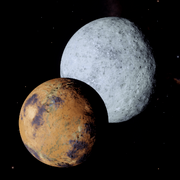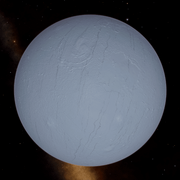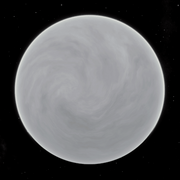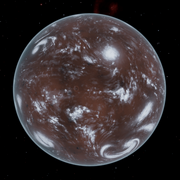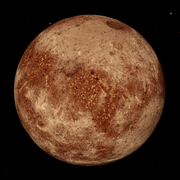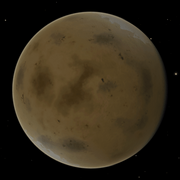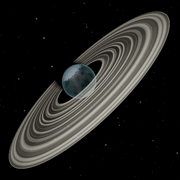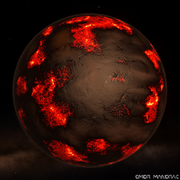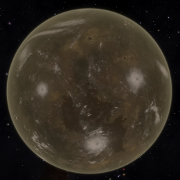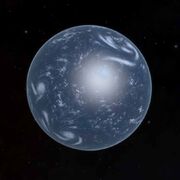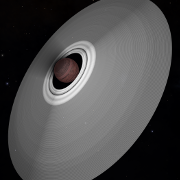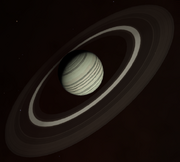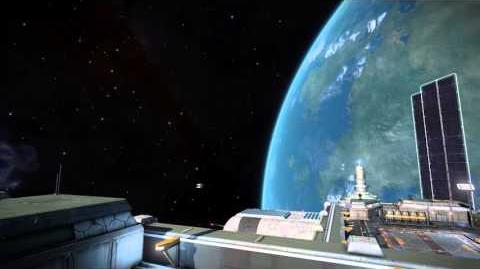There are two main categories of planets: Terrestrial Planets and Gas Giants. Some types of Terrestrial Planets support life or meet the conditions necessary for terraforming. Ships equipped with the Planetary Approach Suite may land on the surface of certain Terrestrial Planets.
The term planet refers to celestial bodies orbiting a star with a gravity in a specific range. The gravity of a planet has to be strong enough to hold fluids and plastic solids in a stable state (hydrostatic equilibrium) which prevents them from escaping the planet and makes the body round, and low enough to prevent nuclear processes to start as in the stars.
Some astronomical objects that meet the official criteria for planet status yet also happen to orbit a planet are instead classified as natural satellites or moons. When the barycentre of the planet-moon system falls outside the planet, then both bodies would be considered planets and part of a double-planet system.[1]
Terrestrial Planets[]
| Image | Type | Rarity | Description |
|---|---|---|---|
| Icy body | Very Common | Ice world composed mainly of water ice. Worlds like this will not have had much heating in the past, forming in the cooler regions of a star system and have retained many volatiles as solids in their crust. | |
| Rocky body | Very Common | Rocky world with little or no surface metal content. Worlds like this have lost most of their volatiles due to past heating, and any metallic content will form a small central core. | |
| Rocky Ice World | Uncommon | Typically formed in the cooler regions of a star system these worlds have a small metal core and thick rocky mantle with a crust of very deep ice. Geological activity is common in these worlds because of the large quantities of volatiles in the crust, often creating a thin, sometimes seasonal atmosphere. | |
| High metal content world | Common | High metal content world with a metallic core. Worlds like this can have metallic ores near the surface in places, especially around areas of past volcanism. | |
| Metal-Rich Body | Uncommon | Metal-rich worlds like this have a large metallic core, with plentiful metallic ores even at the surface. In places, especially around areas of past or current volcanism or liquid erosion, some higher metals can be found in their elemental form too. Mining is therefore very efficient, so these worlds are highly valued. | |
| Ammonia World | Very Rare | Terrestrial ammonia world with an active ammonia-based chemistry and carbon-ammonia based life. | |
| Water World | Rare | Terrestrial water world with an active water-based chemistry and carbon-water-based life. | |
| Earth-like world | Very Rare | Outdoor world with a human-breathable atmosphere and indigenous life. The atmosphere is far from chemical equilibrium as a result. |
Gas Giants[]
| Image | Type | Rarity | Description |
|---|---|---|---|
| Class I gas giant | Common | Class I or Jovian gas giants have primarily hydrogen and helium atmospheres. Colouration comes from clouds in the upper atmosphere of ammonia, water vapour, hydrogen sulphide, phosphine and sulphur. The temperature at the top of their upper cloud layers is typically less than 150 K. | |
| Class II gas giant | Rare | Class II gas giants have primarily hydrogen and helium atmospheres. Water vapour in the upper cloud layers gives them a much higher albedo. Their surface temperature is typically up to or around 250 K. | |
| Class III gas giant | Common | Class III gas giants have primarily hydrogen and helium atmospheres without distinctive cloud layers. Their surface temperature typically ranges between 350 K and 800 K. They are primarily blue in colour because of optical scattering in the atmosphere - with the chance of wispy cloud layers from sulphides and chlorides. | |
| Class IV gas giant | Uncommon | Class IV gas giants have primarily hydrogen and helium atmospheres with carbon monoxide and upper clouds of alkali metals above lower cloud layers of silicates and iron compounds, hence the brighter colours. The temperature of their upper cloud layers is typically above 900 K. | |
| Class V gas giant | Very Rare | Class V gas giants have primarily hydrogen and helium atmospheres, with thick clouds of silicates and iron compounds, even metallic iron.They are the hottest type of gas giants with temperatures at their upper cloud decks above 1400 K, and much hotter in the lower layers, often emitting a dull glow from the internal heat within. | |
| Helium-rich | Very Rare | Helium-rich gas giants have a greatly inflated percentage of helium compared to the hydrogen in their atmosphere. Much of their hydrogen has been lost over time because they have insufficient mass to hold on to it. It may also be because temperatures in their past were much higher, driving off the hydrogen at a greater rate. | |
| Helium gas giant | Extremely Rare | Helium gas giants have primarily a helium atmosphere. They have lost most or all of their hydrogen because they have insufficient mass to hold on to it over time. It may also be because temperatures in their past were much higher, driving off the hydrogen at a greater rate. | |
| Gas giant with ammonia-based life | Very Rare | Gas giant with ammonia-based life. This is primarily a hydrogen and helium-based atmospheric gas giant, but a little below the surface cloud layers, life exists based in the ammonia-cloud layer. The chemistry of this gaseous region is far from equilibrium, with a surprising excess of oxygen and many carbon-based compounds giving it some vivid colours. As with many such gaseous living systems, it is underpinned by vast quantities of free-floating radioplankton - tiny carbon-based algae, each retaining a small quantity of liquid ammonia, extracting their energy from the intense radiation flux. | |
| Gas giant with water-based life | Rare | Gas giant with water-based life. This is primarily a hydrogen and helium based atmospheric gas giant, but not far below the surface exists life based in the water-cloud layer just below the atmospheric surface. The chemistry of this gaseous region is far from equilibrium, with a surprising excess of oxygen and many carbon-based compounds giving it some vivid colours. As with many such gaseous living systems, it is underpinned by vast quantities of free-floating radioplankton - tiny carbon-based algae, each retaining a small quantity of liquid water, extracting their energy from the intense radiation flux. | |
| Water Giant | Very Rare | Water giant. Worlds like this have a large atmosphere made mainly of water vapour. It most likely formed when a large icy body warmed up enough to evaporate a large amount of its surface ice, this would in turn trigger a runaway greenhouse effect leading to a very thick atmosphere made of the evaporated ices. |




